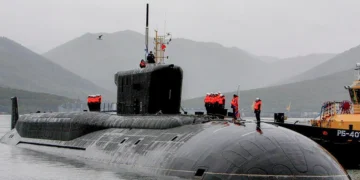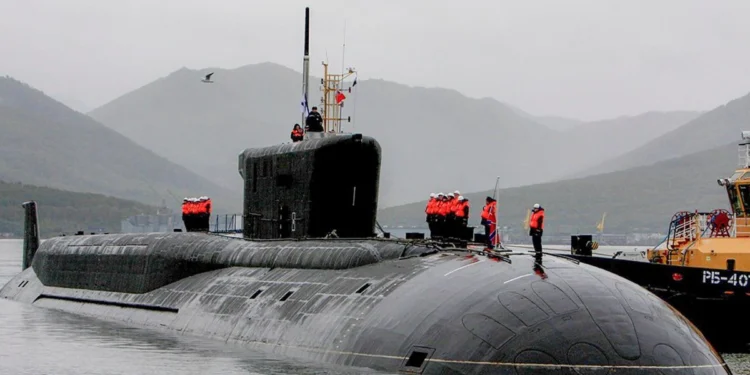Explore the underwater power struggle between the U.S. and Russia as we compare submarine fleets, advanced technology, and naval dominance beneath the oceans.
The United States is deploying two nuclear submarines to strategic locations, reviving a Cold War-era tactic in response to heightened tensions with Russia.

The move follows former Russian President Dmitry Medvedev’s sharp rebuttal to U.S. President Donald Trump’s comment about Russia’s “dead economy.”
After Trump’s earlier threats of tariffs and sanctions failed to sway Moscow, he ordered the submarine deployment to signal a stronger stance against Russian defiance.
The directive was issued last night following Medvedev’s warning to Trump about the ‘dead hand’ — a Cold War-era automated nuclear response system designed to launch a counterstrike even if the nation’s leadership were destroyed.
The Kremlin has yet to respond officially to the threat. However, senior Russian lawmaker Viktor Vodolatsky issued a warning, stating that Russia has a greater number of nuclear submarines deployed across the world’s oceans compared to the United States. He claimed that the submarines which former U.S. President Donald Trump had once ordered to move closer to Russia are already well within Russia’s tracking and control. “The number of Russian nuclear submarines in global waters far exceeds that of the Americans,” Vodolatsky said.
The U.S. Navy’s Ohio-class Ballistic Missile Submarines (SSBNs), commonly known as “boomers,” are renowned for their stealth and precision in delivering nuclear payloads. Currently, at least 14 of these submarines are active in service. Engineered for long-duration deterrent patrols, they can operate for up to 15 years without requiring a major overhaul. Each submarine is capable of carrying up to 20 submarine-launched ballistic missiles (SLBMs), with the Trident II D5 serving as their primary strategic weapon.
American Fast Attack Submarines
The United States Navy fields three classes of nuclear-powered fast attack submarines (SSNs): the Virginia-class, Seawolf-class, and Los Angeles-class (688-class). These advanced submarines are armed with Tomahawk cruise missiles, Harpoon anti-ship missiles, and MK-48 torpedoes, enabling them to hunt and destroy enemy vessels with precision. Beyond combat roles, they are also equipped for intelligence gathering, surveillance and reconnaissance (ISR) missions, and mine warfare, making them versatile assets in modern naval operations.

The United States operates 24 Virginia-class nuclear-powered attack submarines (SSNs), including vessels like the USS Hawaii, USS North Carolina, and USS Missouri. As the newest class in the U.S. Navy’s undersea warfare fleet, the Virginia-class incorporates advanced technologies and design innovations. These submarines are specially equipped to support special operations forces, featuring unique capabilities such as a lock-in/lock-out chamber that allows divers to deploy while submerged.
The U.S. Navy operates three Seawolf-class submarines, with the first—USS Seawolf—commissioned in 1997. Unlike some other attack submarines, the Seawolf-class does not feature a vertical launch system. Instead, it is equipped with eight torpedo tubes and a torpedo room capable of carrying up to 50 weapons.
The 688-class, also known as the Los Angeles-class, forms the backbone of the U.S. Navy’s submarine fleet. Introduced in 1976 to counter the Soviet threat during the Cold War, these submarines have demonstrated exceptional speed, stealth, and operational effectiveness. Currently, at least 24 remain in active service. As they approach retirement, the Virginia-class submarines are set to gradually replace them, ensuring continued undersea superiority for the U.S. Navy.
Russian Ballistic Missile Submarines
Russia maintains one of the largest submarine fleets in the world, with approximately 64 active vessels. Among these, around 14 are ballistic missile submarines (SSBNs), which play a vital role in the country’s strategic nuclear deterrence. The fleet primarily includes submarines from the advanced Borei-class and the older, but still operational, Delta IV-class.
The Russian Navy operates eight Borei-class nuclear-powered ballistic missile submarines (SSBNs). Each is armed with 16 Bulava submarine-launched ballistic missiles (SLBMs) and six 533mm torpedo tubes. These submarines are also capable of launching anti-submarine rockets and deploying bottom mines. A typical crew consists of over 100 sailors.
The Borei-class submarines are set to replace the aging Delta IV-class vessels, which were developed alongside the larger Typhoon-class. Currently, at least six Delta IV submarines remain in active service. Each is equipped with 16 Sineva submarine-launched ballistic missiles (SLBMs), forming a critical component of Russia’s sea-based nuclear deterrent.
The Russian Navy operates four Yasen-class nuclear-powered attack submarines, which are more compact and require fewer crew members than their predecessors. Each submarine is equipped to carry either up to five 3M54-1 Kalibr cruise missiles or four P-800 Oniks (32-40) missiles. This armament gives the Yasen-class submarines formidable long-range land-attack and anti-ship capabilities.
The Akula-class submarines—nicknamed “Shark” (as Akula means shark in Russian)—are among the Russian Navy’s most formidable and stealthy underwater assets. With around five currently in service, these nuclear-powered attack submarines were developed as a counter to the U.S. Navy’s Los Angeles-class. Armed with an array of advanced weaponry, including Kalibr, Oniks, and Granit cruise missiles, along with torpedoes, the Akula-class is designed for silent, lethal operations beneath the surface.
READ ALSO……IIT Bombay Mourns Loss of Student in Suspected Suicide 2 AUGUST















 Categories
Categories









